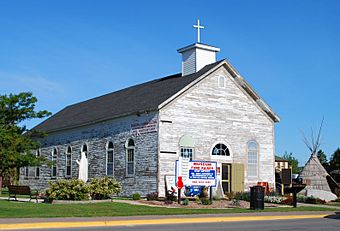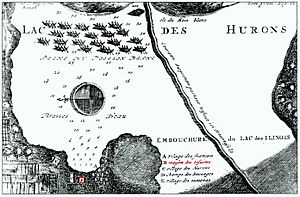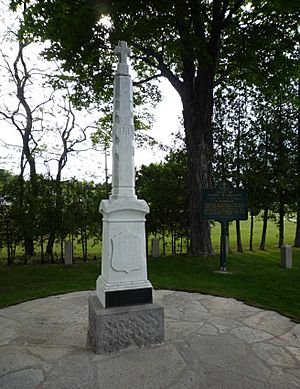St. Ignace Mission facts for kids
|
St. Ignace Mission
|
|

Mission in 2009
|
|
| Location | State and Marquette Sts., Marquette Park, St. Ignace, Michigan |
|---|---|
| Built | 1837 |
| NRHP reference No. | 66000398 |
Quick facts for kids Significant dates |
|
| Added to NRHP | October 15, 1966 |
| Designated NHL | October 9, 1960 |
The St. Ignace Mission (also known as Mission Saint-Ignace in French) is a very old and important place in Michigan. It's located in a park called Marquette Mission Park. This spot was once home to a mission started by a French Catholic priest named Father Jacques Marquette. He was even buried here in 1677. Later, in 1837, a second mission was built nearby. Its chapel was moved to this historic site in 1954. This chapel is the oldest Catholic church building in both Michigan and Wisconsin! The St. Ignace Mission was recognized as a Michigan State Historic Site in 1956. It became a U.S. National Historic Landmark in 1960, making it one of the first places to get this special title. Today, the mission chapel is home to the Museum of Ojibwa Culture.
Contents
The Story of St. Ignace Mission

The St. Ignace Mission has a long and interesting history, starting with brave explorers and missionaries.
Father Marquette's First Mission
In 1670, another priest named Claude Dablon started a Catholic mission on Mackinac Island. It seems that mission didn't last, because in 1671, Father Jacques Marquette started a new French Jesuit mission in the same area. Jesuit priests are members of a Catholic religious order.
However, later that year, Father Marquette moved his mission. He chose a spot on the north shore of the Straits of Mackinac, which is where the mission chapel stands today. There, he built a small log cabin to use as a church. He worked with the Native American people living nearby, especially the Petun tribe. These people had recently moved to the area after conflicts with the Iroquois tribe and French settlers.
In 1674, Father Marquette went on an important journey with Louis Jolliet. They explored the route of the Mississippi River. During this trip, Marquette became very sick. He passed away in 1675 while trying to return to his St. Ignace mission. He had wished to be buried at the mission. So, in 1677, his followers carefully moved his body. They placed it in a birch box and buried it under the chapel at St. Ignace.
What Happened to the First Mission?
After Father Marquette died, other priests took over the mission. A new chapel was built around 1674. By 1683, the mission was doing very well, with three priests working there. But things changed when a French military base was set up in St. Ignace in 1679. This caused problems between the French and the local Native American people.
In 1701, a French leader named Antoine Laumet de La Mothe, sieur de Cadillac left St. Ignace to start a new city, Detroit. Many people from St. Ignace went with him. This made the mission much less important.
The St. Ignace mission stayed open until 1705, when it was closed and burned by Father Étienne de Carheil. It reopened in 1712 and operated on the north shore of the Straits until 1741. Then, it moved to the south shore. After the mission moved, people forgot the exact spot where Father Marquette's first chapel had been.
The Second Mission Chapel
The area where the first mission stood was mostly empty for a long time after 1741. But in the early 1800s, people slowly started to settle there again. By 1836, enough Catholic families lived in the area to need a church.
So, in 1837, a second mission was built in St. Ignace. It was about a mile south of where the first mission had been. Church services began in this new chapel in late 1837 or early 1838. At first, priests from Mackinac Island came to lead services. But in 1855, Rev. S. Carié arrived as the first full-time priest. Many priests served the church over the next 50 years.
In 1877, the original site of Father Marquette's first mission was found by accident! Digging at the site showed that it matched old descriptions of the mission. In the early 1900s, a marble statue was placed there. The area became a city park to honor Father Marquette.
Between 1882 and 1885, the second mission chapel was made longer. By 1901, the church building was getting old and worn out. The community decided to build a brand new church. They raised money, and the new St. Ignatius Loyola Church was finished in 1905. The second mission chapel was no longer used for services after that.
The Mission Today
The second mission chapel sat empty until 1926. Then, a woman named Mrs. Catherine Chambers-Gleason bought and fixed it up. The church became a history museum, showing old items from early St. Ignace. The Knights of Columbus group helped run it. In 1954, the chapel was moved from its old spot to the site of the first mission. It has been there ever since. More recently, archaeologists studied the mission site and a nearby Petun village in the 1970s and 1980s.
In the late 1980s, the chapel became the Museum of Ojibwa Culture. It still serves this purpose today. The museum teaches visitors about the Ojibwa people's culture and how they lived. It also shows how the movement of Huron and Odawa tribes affected the area. The St. Ignace Downtown Development Authority manages the museum. The chapel itself was restored between 2008 and 2010. This work included fixing the windows, replacing some of the outer wooden boards, and repainting the inside and outside.
What the Mission Looks Like
The place where Father Marquette's first mission stood is now a city park. It's at the corner of State and Marquette Streets in St. Ignace. The park is about 300 feet from the shore of Lake Huron. Father Marquette's burial spot is in the southwest part of the park. The second mission chapel is on the east side of the park.
The chapel is a simple, one-story building made of wood. It has wooden clapboards on the outside and a sloped roof. It used to have a tall steeple, but now it has a wooden cross instead. Double doors on one end open into the main room where services were held. At the other end is the altar, with doors leading outside on either side. The building originally had a small porch and an extra section on one corner, probably used as a home.
| Second mission chapel gallery
|
|---|








